[Spectrum, MAP Software]
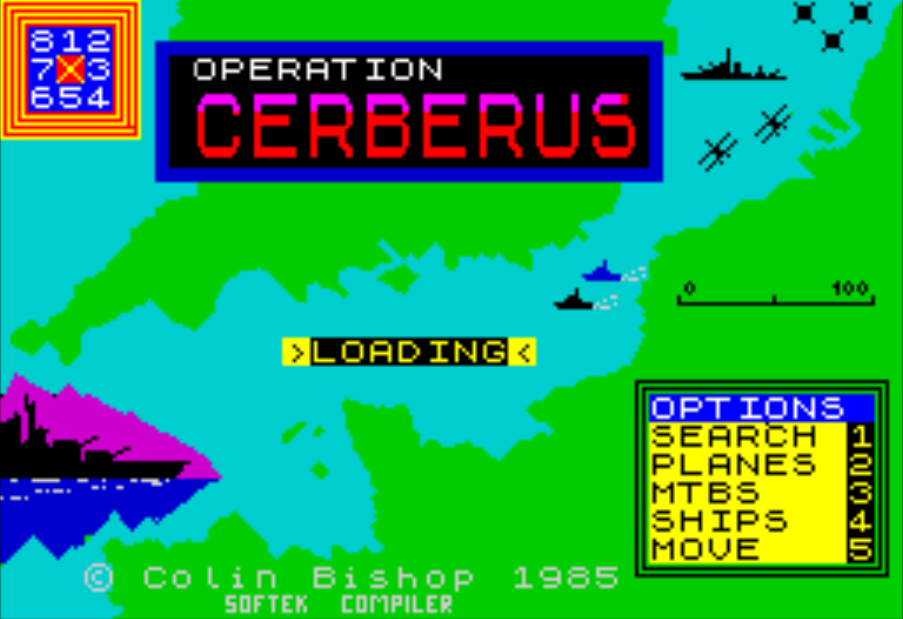
My reserve of quick Spectrum games to use as a filler has exhausted for 1984, so I am now pulling in advance from my 1985 list. Still, I don’t have any qualms about covering Operation Cerberus ahead of schedule: the game seems to have barely sold and its publisher MAP Software had zero impact on the hobby – I could not find any ad or review for this game, and could not even find the exact release date. Moreover, the only other MAP software game (Raider ’41), by the same author, currently sits at the bottom of the 173 non-fraud games I rated so I am unlikely to experience something new out of order.
I was also eyeing this game for its original and titular theme. Operation Cerberus (aka the Channel Dash) was a German attempt to transfer three of their most powerful remaining warships (the battleships Scharnhorst and Gneisenau and the heavy cruiser Prinz Eugen) from Brest to Germany, unexpectedly using the Channel rather than a safer scenic route through the Atlantic and the North Sea. The operation was a success, allowing the Germans to squeeze a bit more mileage from their ships in the Norwegian and Baltic seas.
Operation Cerberus puts the player of the command of the British and their vast capabilities, with only one objective for the player: sink the three ships! Will the game join Raider ’41 at the bottom of the list or will it just be the normal kind of bad?
After selecting the two tiles in the top-right corner for mining, I am informed that the German fleet has left Brest. For now, the only action available is “search”, which I can do between 2 and 5 times every turn, depending on the weather.
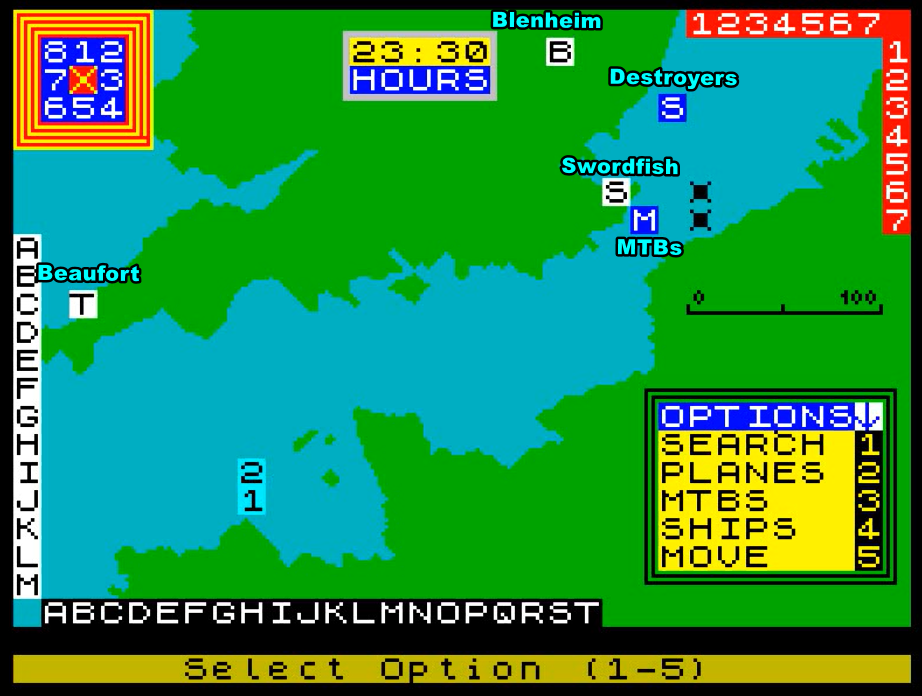
After searching fruitlessly in the North of Brittany, I decide to search every turn between the Cotentin peninsula and the Isle of Man, as the passage is only 3 tiles wide. At 4 in the morning, I find the enemy fleet!
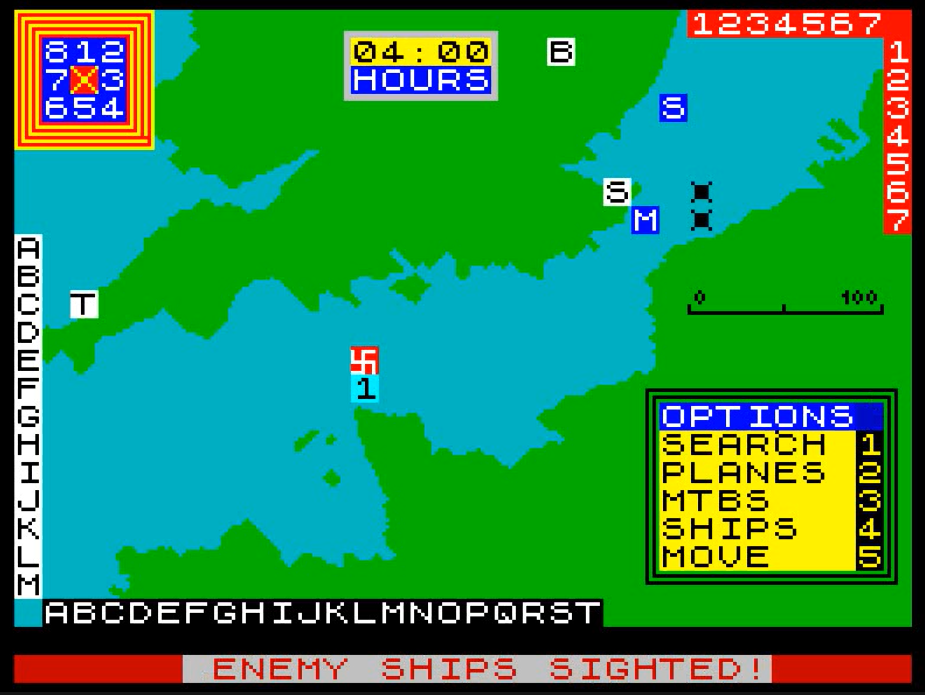
This starts the activation process of my reaction force, though I have to wait 90 more minutes (or 180 for the Blenheim) before I am allowed to move my assets. Once they can finally take off or leave their ports, all my planes and ships converge toward the German Fleet, except the Beaufort which can apparently join up with their escort East of London. Given where they start from, the Swordfish encounter the German fleet first at 7 AM:
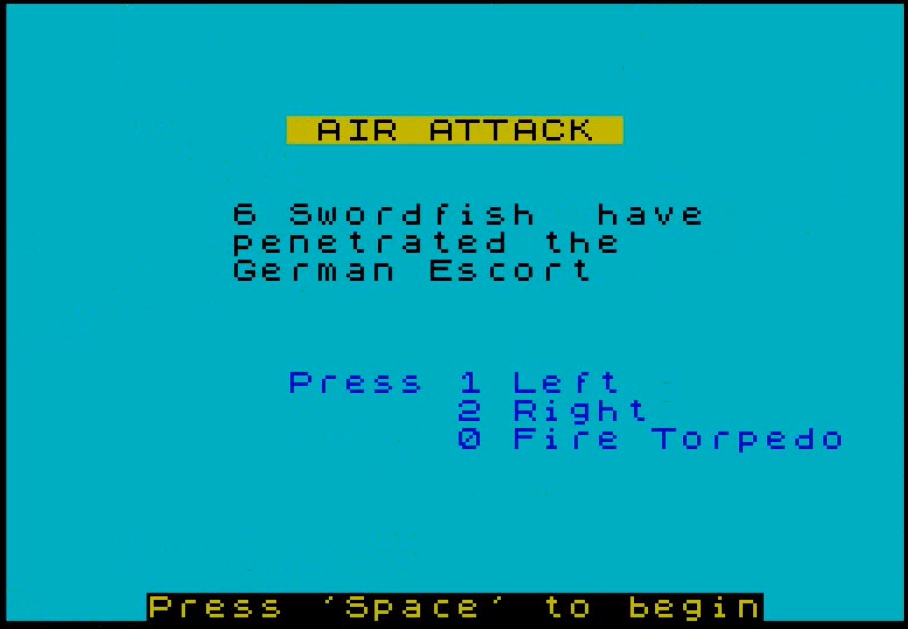
The attack phase is actually a slick mini-game: my Swordfish must approach a randomly selected warship and drop one torpedo. It is harder than it looks: the ships are fast, torpedoes fail if they are launched too close to the enemy ship and AA guns can one-shot the plane. I have 6 planes so 6 torpedoes to launch, but I only hit the Prinz Eugen once.
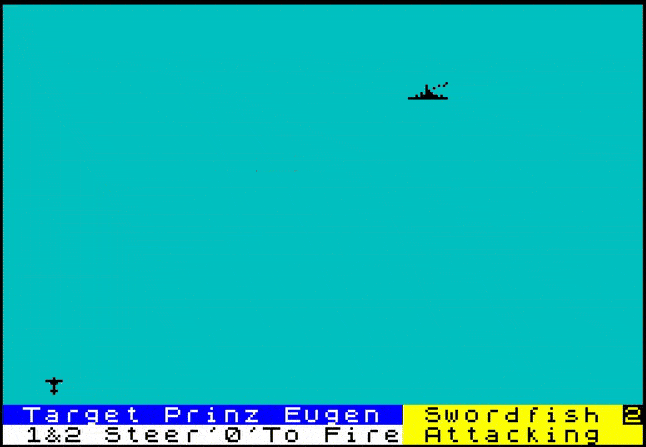
After the Swordish, the Blenheim arrive over the German fleet. Unlike the Swordfish, they are level bombers, so their attack pattern is different: 3 small pixels that must appear on the target. It’s much harder than with the Swordfish as you effectively need to fly above the warships to drop your payload, and you can still miss if you do everything perfectly, given the warship fits in the space between the pixels.
I have 7 Blenheim but I don’t achieve anything with the 4 first ones. However, I learn from experience and finally hit the Scharnhost and the Prinz Eugen with the remaining ones:
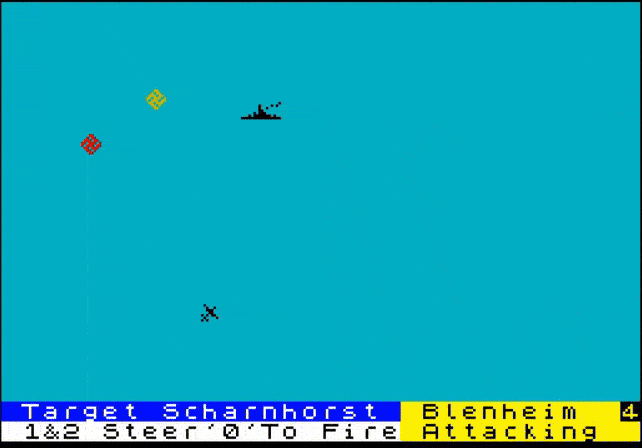
Unlike the Swordfish, the Blenheim squadron is “respawned” at its airbase after attacking the German fleet, so everything I learned will be useful again.
After the planes, it is the turn of the motor torpedo boats (MTBs) to engage the enemy:
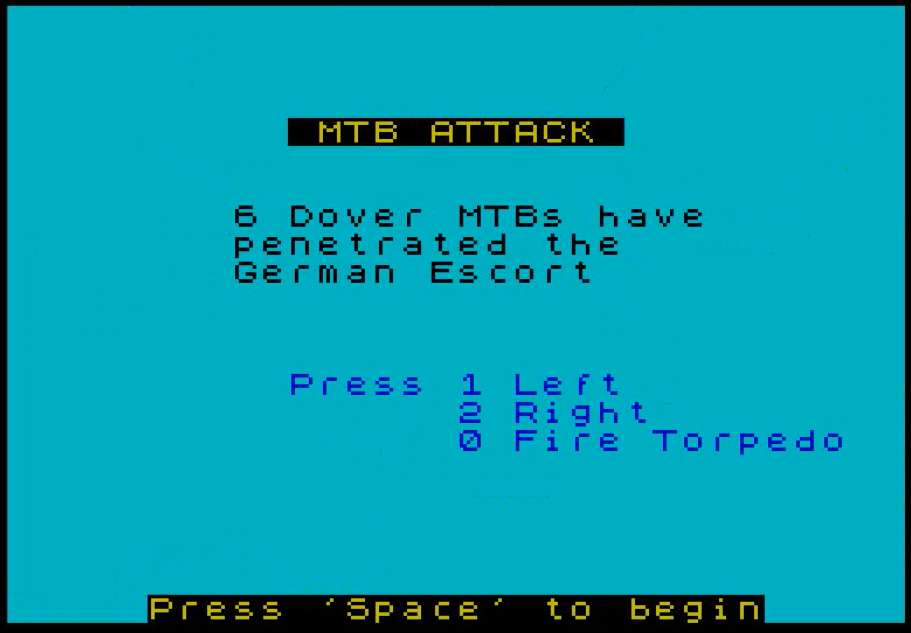
The MTBs follow the same rules as the Swordfish, except that they’re much slower so sometimes they don’t even have a chance to catch the warship. The speed differential also means that they are way more likely to be hit in their approach than planes. I could not hit the enemy even once.
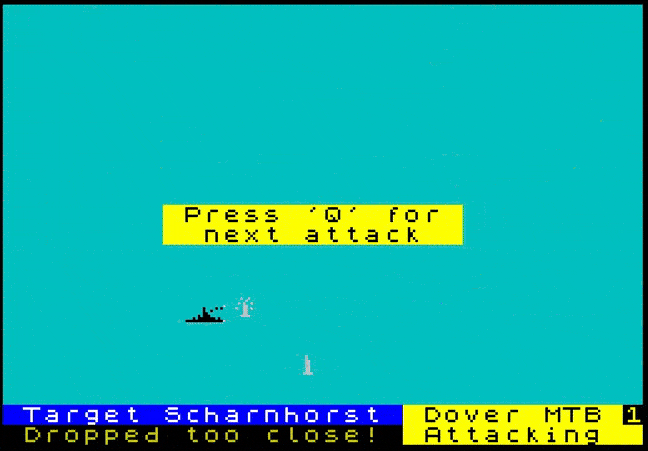
Finally, the Beaufort reach the enemy after getting some escort. The mini-game is the same as with the Swordfish, but I test a new approach where I attack from the front of the ship. I am somewhat successful: 2 hits!
It is now 9 in the morning, and I am left with only the respawning Blenheim and the destroyers – everything else is dead icons on the map.
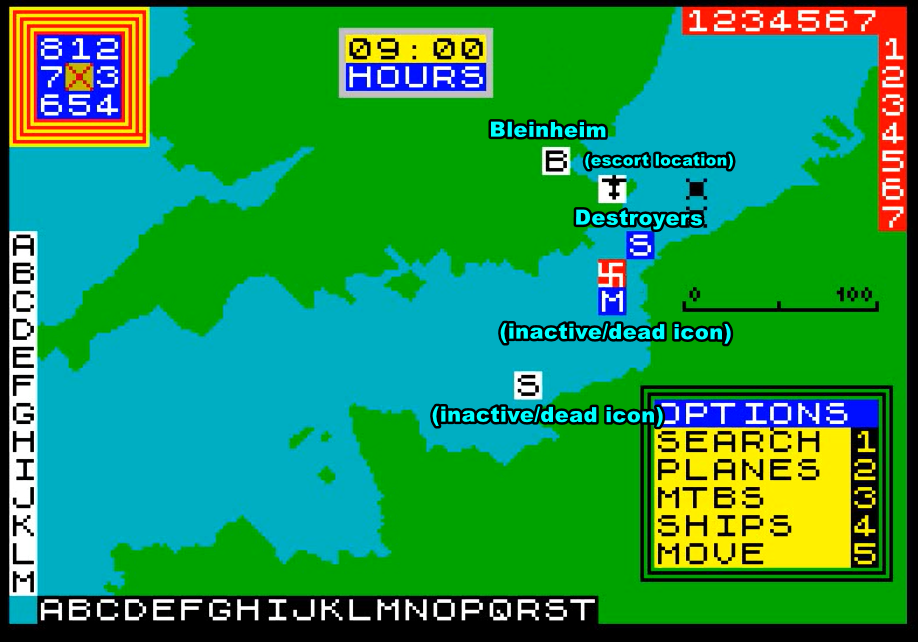
It’s not looking good, but it’s not like I have a plan B so my 6 destroyers engage the German fleet of two battleships and 1 heavy cruisers. The odds are not in my favour but – eh! – it’s a new mini-game!
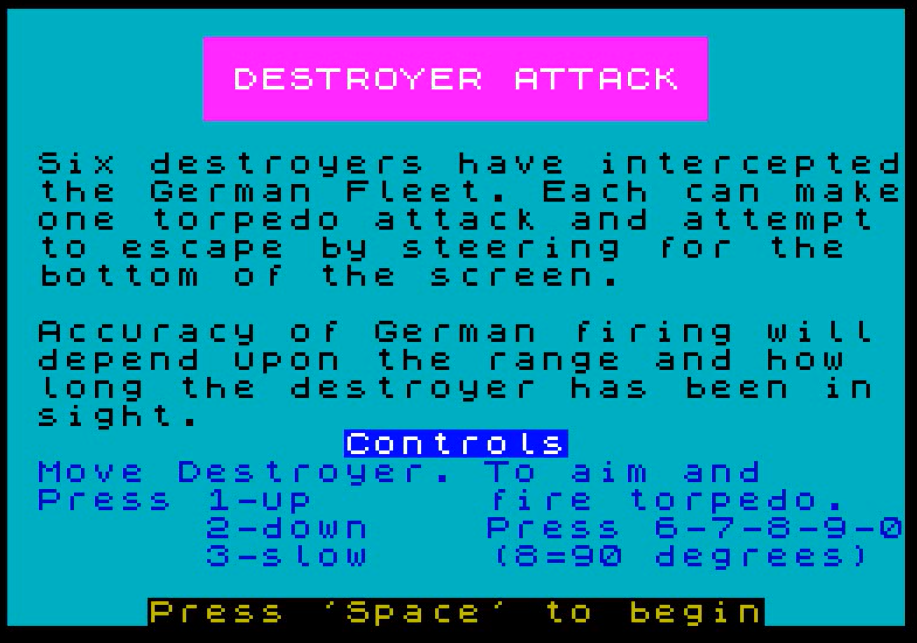
This mini-game is more chill: I need to send a torpedo so it hits one of the enemy warships, then disengage at the bottom of the screen. The first destroyer is wasted while I understand the rules, the second and the fourth strike true:

As the Germans approach the narrowest part of the straight of Dover, I have the last segment of this British Combined waiting for them:
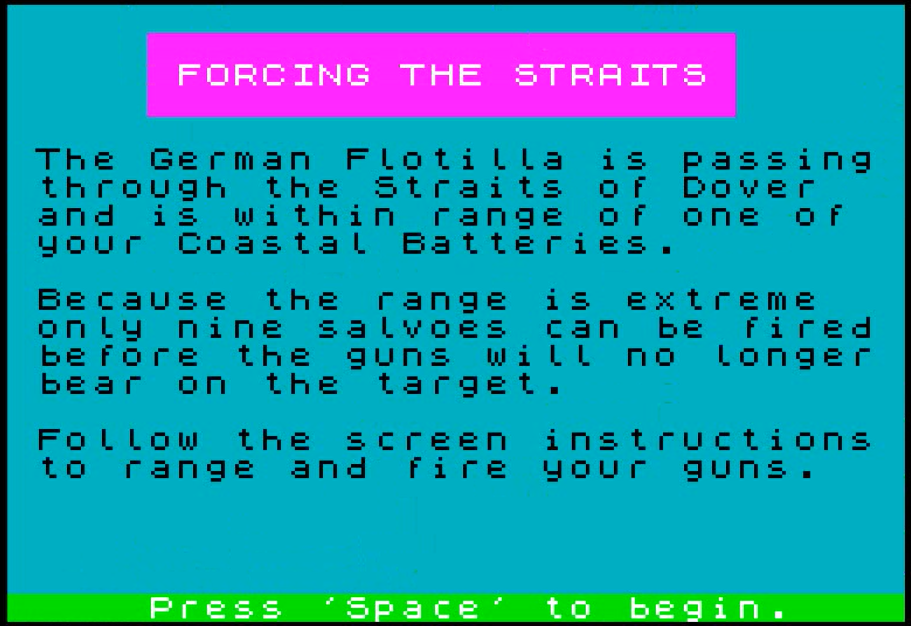
This is a typical artillery game, though the context makes it more fun than its peers. The ships slightly move after each attack, but I still manage to hit the Scharnhorst 4 times!
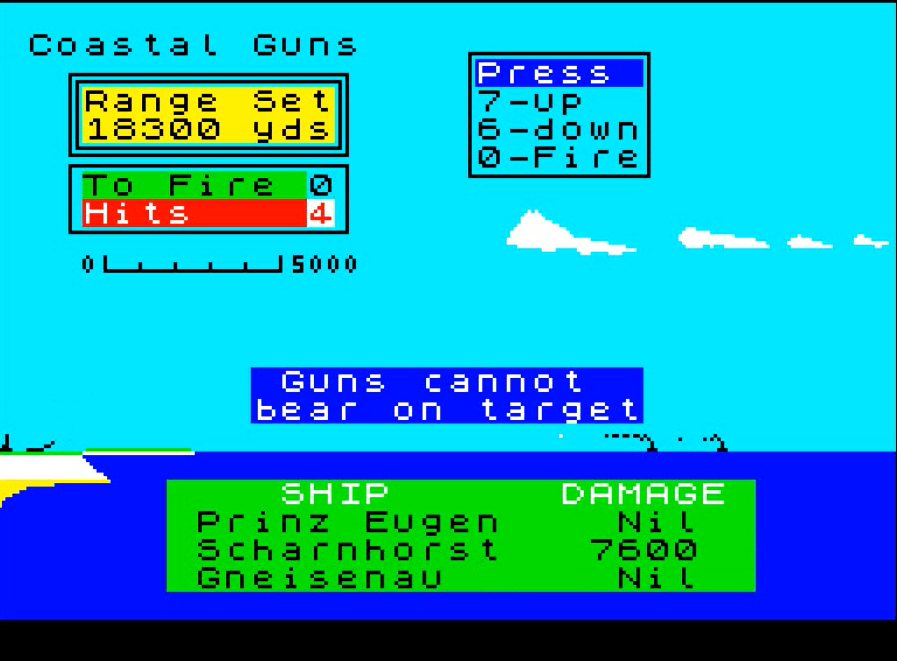
It hit the Scharnhorst 4 times… but somehow that’s the Gneisenau that I sank! Bah, Battleship schmattleship.

I immediately follow up with an ineffective Blenheim attack. The Prinz Eugen then encounters one of my mines, for more damage – but she is still floating.
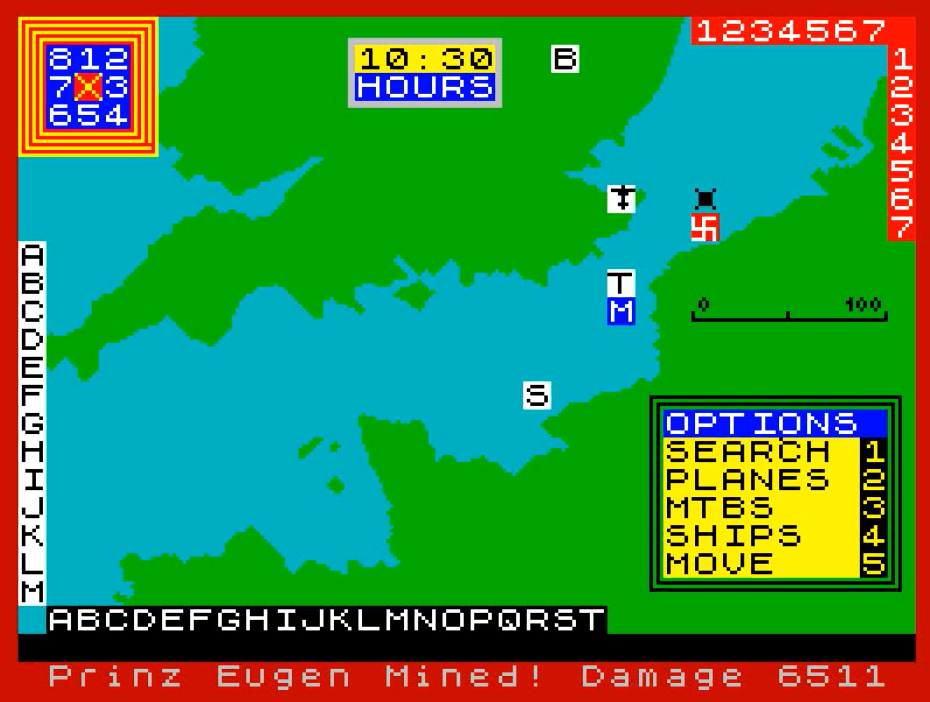
After one more interception with my Blenheim where I only manage to damage the Scharnhorst, the Germans exit the map and end the game.
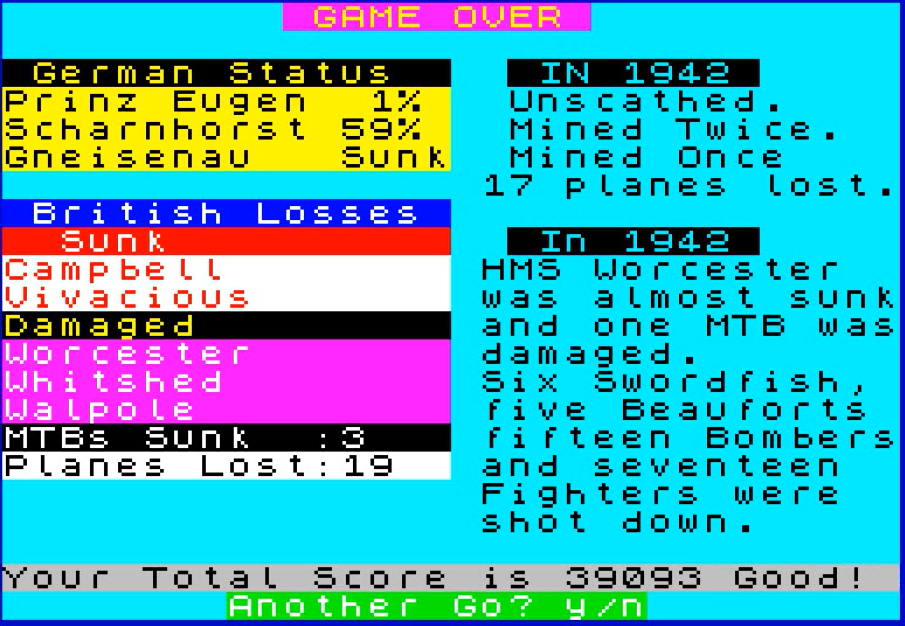
I suspect the Prinz Eugen was notionally sunk by the mines, but I needed to hit it once more with my planes to confirm it. Still, I don’t think a ship at 1% can be repaired during the war, so I did better than historically. “Good” indeed!
Ratings & Review
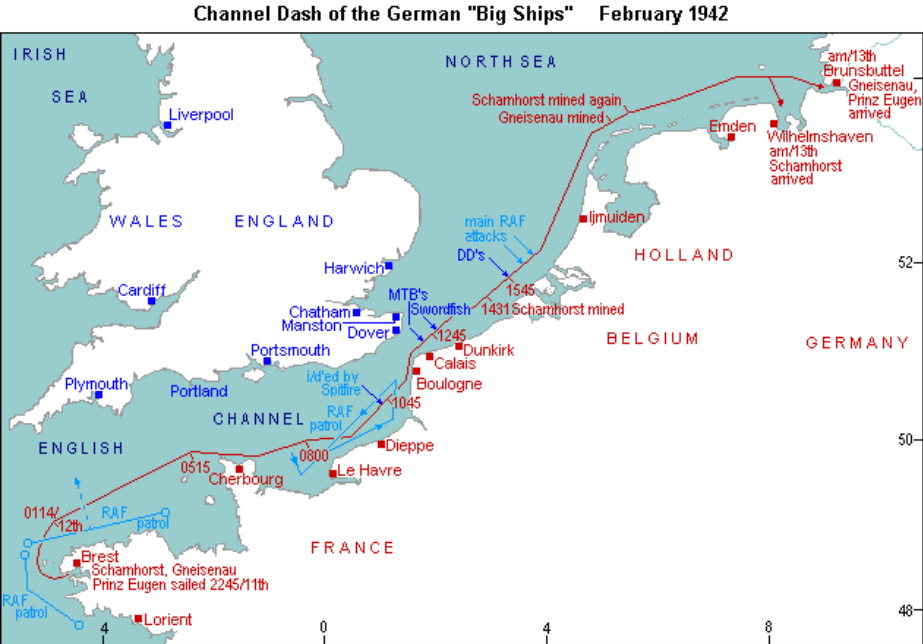
Operation Cerberus, by Colin Bishop, published by MAP Software, UK
First release: Somewhere in 1985, probably, on ZX Spectrum
Genre: Strategy-Arcade
Average duration of a campaign : Exactly 28 minutes for my playthrough
Total time played : 35 minutes
Complexity: Trivial (0/5)
Final Rating: ☆
Context – I have nothing new to say about Colin Bishop and on MAP Software since my article on Raider ’41. MAP stands for Model and Allied Publications and is a branch of Argus Press Software selling guides on modelling. It released a few specialist software on the topic, and only two games: Raider ’41 and Operation Cerberus.
Traits – Operation Cerberus is classified as a strategy game in SpectrumComputing, but that’s a lie: there is no decision whatsoever to take on the strategic map. Once the German fleet is detected, it remains so forever so you don’t have to split your assets between search, shadowing and combat – you can just send everything you have immediately. Operation Cerberus is therefore a collection of mini-games, which are… actually fun? The mini-games are fast, fluid and fair, they are also connected by a broad narrative that more interesting than say “the Olympics” in Summer Games so I liked it. I have no reason to play it again, and given I don’t expect to encounter another Operation Cerberus game (do any even exist?), my reality of Operation Cerberus is that the Gneisenau was sunk and the Prinz Eugen out of commission for the rest of the war.
Did I make interesting decisions? No! It was all about twitchy fingers!
Final rating: ☆. Listen: I know it is a simple arcade game, but I had some fun, I liked the theme, I like how it was dressed like a strategy game and I finished the game in half an hour. If it had taken one hour or more, the game would have slided into the “Obsolete” category, but as it did not overstay its welcome it remained a better experience than more than half of the games I played so far!
Ranking at the time of review: 69/174 – just above the strategy-arcade Panzer War, which was similarly mostly arcade, a bit more deep but also a bit more repetitive.
Two small notes to conclude this
- My coverage of Brøderbund’s Ancient Art of War is approaching, so if you want to make a scenario for me to play, it is the moment, because I will play it. Ahab has prepared a package here with instructions so you can level design and save your work easily!
- While preparing my list for 1985, I found two 1983 games that I had missed: Humphrey Walmyn’s Waterloo and Dreadnought, complex type-in games found in a book called “Micro-War for the Commodore 64“. When I investigated them, it turns out that they were multiplayer-only, but friend of the blog WhatHoSnorkers played them, and I particularly recommend his coverage of the latter.
4 Comments
Hooray! It’s good to come across a good game, and nice to see the Prinz Eugen back in action. I believe in the end they dropped an atomic bomb on it…
This does look fun for 30 minutes or so. Dreadnought is good for a 2 player game. I’m still looking at Waterloo; there are some interesting choices and I’ve started doing improvements but it’s been a couple of years! One of the more bizarre Waterloo choices is that it covers the whole campaign but ends at noon on 18th June… which is when the Battle of Waterloo started.
fyi Ancient Art of War at Sea is a fav. It is much better than Ancient Art of War.
Great article! Wild that it has mini games, but seems a wargame.
I absolutely agree about AAWaS, and we even coerced the DataDrivenGamer to eventually cover the release (check the comments here: https://datadrivengamer.blogspot.com/2023/06/the-ancient-art-of-war-islands-of-doom.html)
Love that you have to specify “non-fraud”.